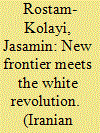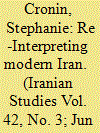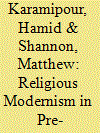|
|
|
Sort Order |
|
|
|
Items / Page
|
|
|
|
|
|
|
| Srl | Item |
| 1 |
ID:
051004


|
|
|
|
|
| Publication |
Boca Raton, University Press of Florida, 2003.
|
| Description |
ix, 229p.hbk
|
| Standard Number |
081302630X
|
|
|
|
|
|
|
|
|
|
|
|
Copies: C:1/I:0,R:0,Q:0
Circulation
| Accession# | Call# | Current Location | Status | Policy | Location |
| 047950 | 955.0508631/NAB 047950 | Main | On Shelf | General | |
|
|
|
|
| 2 |
ID:
160287


|
|
|
|
|
| Summary/Abstract |
The Peace Corps brought an estimated 1,800 Americans to Iran from 1962 to 1976, coinciding with the unfolding of Mohammad-Reza Shah Pahlavi’s Enqelāb-e Sefid, or White Revolution. This article surveys Peace Corps Iran’s fourteen-year history by dividing it into three distinct moments defined by changing social and political conditions in Iran and shifting US‒Iranian relations. Initially, the Peace Corps Iran experiment built on earlier American foreign assistance programs, while coinciding with the roll-out of the White Revolution. Second, during its heyday in the mid-1960s, the Peace Corps inevitably became entangled with the White Revolution’s unfolding, both experiencing a phase of expansion and apparent success. Finally, as Iranian social and political conditions moved toward instability by the 1970s, Peace Corps Iran also seemed to have lost its direction and purpose, which ultimately led to a vote by volunteers to terminate the program. Based on accounts by US Peace Corps volunteers and the Iranians with whom they worked, the Peace Corps Agency, and the US State Department, this article argues that, ultimately, the Peace Corps Iran experience left a more lasting legacy on individuals than institutions.
|
|
|
|
|
|
|
|
|
|
|
|
|
|
|
|
| 3 |
ID:
155083


|
|
|
|
|
| Summary/Abstract |
Having been introduced to the scholarly community and the general public through a variety of photographic presentations during the inter-war period, monuments in Iran, particularly those of pre-modern Islamic periods, became key buildings to be seized upon as the ultimate embodiment of Persian beauty. The lasting image of Persian Islamic architecture that was articulated through photographs continues not only to set an important benchmark for the understanding of the aesthetic and political matrix of the early twentieth century but also to provoke a methodological question as to the future of Persian architectural studies.
|
|
|
|
|
|
|
|
|
|
|
|
|
|
|
|
| 4 |
ID:
089051


|
|
|
|
|
| Publication |
2009.
|
| Summary/Abstract |
For the nationalist elite of early Pahlavi Iran, the regime's military successes over tribal opposition, whether real or imagined, were welcomed and celebrated. These successes were interpreted as confirmation of their views of tribal power as hostile to modernity, archaic and outmoded, and of Riza Shah as the deliverer of Iran's national salvation. This conceptualization of the "tribal problem" had appeared in tandem with and as a product of modernist ideology in the late nineteenth century, acquired the backing of state power with the rise of the Pahlavi dynasty, and endured until the revolution of 1979. It communicated itself, in diluted form, to Western scholarship, which has been largely content to depict Riza Shah's tribal policies as regrettably brutal, but an unavoidable stage in Iran's progress and "modernization."
Yet this version of tribe-state relations is clearly an ideological construct rather than an historical analysis. The account which follows begins a re-evaluation of tribal politics in modern Iran, focusing especially on the Riza Shah decades when these politics were a site of intense conflict and where the nationalist template was most starkly delineated, and concludes by tracing and re-examining the evolution of the tribe-state dynamic in the decades of land reform and revolution.
|
|
|
|
|
|
|
|
|
|
|
|
|
|
|
|
| 5 |
ID:
178777


|
|
|
|
|
| Summary/Abstract |
The advent of “modern” education in Iran and its acceptance by political and cultural elites dates to the Qajar era. But the elitist nature of state reforms prevented modern education from spreading throughout society until the Pahlavi era. Especially during the reign of Mohammad Reza Shah Pahlavi, modern education reached most segments of the population, including religious families from the middle classes. This research is based on Persian-language documents and informed by the English-language historiography. The article finds that the Islamic Education Society (Jāmeʿeh-ye taʿlimat-e eslāmi) propagated religious modernism through a national network of private schools beginning in the 1940s. In the 1950s and 1960s private cultural foundations used the Islamic Education Society’s model to establish the Alavi, Kamāl, and Refāh schools in Tehran. The network that supported them was a reflection of the revolutionary movement and a vehicle for its organization by the 1970s.
|
|
|
|
|
|
|
|
|
|
|
|
|
|
|
|
| 6 |
ID:
192996


|
|
|
|
|
| Summary/Abstract |
This paper examines the Pahlavi Dynasty Museum, which was inaugurated in 1976 during the celebrations marking the fiftieth anniversary of Pahlavi rule. Built inside the Marble Palace, the shah's former residence in the center of Tehran, the museum was intended to memorialize the achievements of the Pahlavis, presenting the official Pahlavi version of Iran's modern history. The museum was unique in many respects, not least because it was the only former Pahlavi palace that had been converted into a museum to honor the Pahlavis, but it shared the objectives of other museums constructed during this period. During the late Pahlavi era, a major aspect of the state's cultural policy was to sponsor initiatives that strengthened the official state narrative, which argued that the Pahlavis were the legitimate heirs of a 2500-year-old monarchical tradition. The article explores how the state attempted to express these narratives through the museum's design and exhibits.
|
|
|
|
|
|
|
|
|
|
|
|
|
|
|
|
|
|
|
|
|